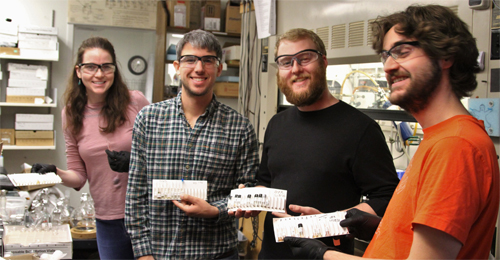
This article was republished on the yahoo!news site from The Conversation, a nonprofit news site dedicated to sharing ideas from academic experts. © 2021 Verizon Media. All rights reserved.
And Copyright © 2010–2021, The Conversation US, Inc.
By Kerry Rippy, Electrochemistry Postdoctoral Research Associate, National Renewable Energy Laboratory
It’s 4 a.m. A loud alarm is blaring, accompanied by red strobe lights flashing. A stern voice announces, “Searching station B. Exit immediately.” It feels like an emergency, but it’s not. In fact, the alarm has already gone off 60 or 70 times today. It is a warning, letting everyone in the vicinity know I’m about to blast a high-powered X-ray beam [from the U.S. Department of Energy's Advanced Photon Source at Argonne National Laboratory] into a small room full of electronic equipment and plumes of vaporizing liquid nitrogen.
In the center of this room, which is called station B, I have placed a crystal no thicker than a human hair on the tip of a tiny glass fiber. I have prepared dozens of these crystals, and am attempting to analyze all of them.
These crystals are made of organic semiconducting materials, which are used to make computer chips, LED lights, smartphone screens and solar panels. I want to find out precisely where each atom inside the crystals is located, how densely packed they are and how they interact with each other. This information will help me predict how well electricity will flow through them.
To see these atoms and determine their structure, I need the help of a synchrotron, which is a massive scientific instrument containing a kilometer-long loop of electrons zooming around at near the speed of light. I also need a microscope, a gyroscope, liquid nitrogen, a bit of luck, a gifted colleague and a tricycle.
The first step of this experiment involves placing the super-tiny crystals on the tip of the glass fiber. I use a needle to scrape a pile of them together onto a glass slide and put them under a microscope. The crystals are beautiful – colorful and faceted like little gemstones. I often find myself transfixed, staring with sleep-deprived eyes into the microscope, and refocusing my gaze before painstakingly coaxing one onto the tip of a glass fiber.
Once I’ve gotten the crystal attached to the fiber, I begin the often frustrating task of centering the crystal on the tip of a gyroscope inside station B. This device will spin the crystal around, slowly and continuously, allowing me to get X-ray images of it from all sides.
As it spins, liquid nitrogen vapor is used to cool it down: Even at room temperature, atoms vibrate back and forth, making it hard to get clear images of them. Cooling the crystal to minus 196 degrees Celsius, the temperature of liquid nitrogen, makes the atoms stop moving so much.
Once I have the crystal centered and cooled, I close off station B, and from a computer control hub outside of it, blast the sample with X-rays. The resulting image, called a diffraction pattern, is displayed as bright spots on an orange background.
What I am doing is not very different from taking photographs with a camera and a flash. I’m about to send light rays at an object and record how the light bounces off it. But I can’t use visible light to photograph atoms – they’re too small, and the wavelengths of light in the visible part of the spectrum are too big. X-rays have shorter wavelengths, so they will diffract, or bounce off atoms.
However, unlike with a camera, diffracted X-rays can’t be focused with a simple lens. Instead of a photograph-like image, the data I collect are an unfocused pattern of where the X-rays went after they bounced off the atoms in my crystal. A full set of data about one crystal is made up of these images taken from every angle all around the crystal as the gyroscope spins it.
My colleague, Nicholas DeWeerd, sits nearby, analyzing data sets I’ve already collected. He has managed to ignore the blaring alarms and flashing lights for hours, staring at diffraction images on his screen to, in effect, turn the X-ray images from all sides of the crystal into a picture of the atoms inside the crystal itself.
The U.S. Department of Energy's APS is one of the world’s most productive x-ray light source facilities. Each year, the APS provides high-brightness x-ray beams to a diverse community of more than 5,000 researchers in materials science, chemistry, condensed matter physics, the life and environmental sciences, and applied research. Researchers using the APS produce over 2,000 publications each year detailing impactful discoveries, and solve more vital biological protein structures than users of any other x-ray light source research facility. APS x-rays are ideally suited for explorations of materials and biological structures; elemental distribution; chemical, magnetic, electronic states; and a wide range of technologically important engineering systems from batteries to fuel injector sprays, all of which are the foundations of our nation’s economic, technological, and physical well-being.
Argonne National Laboratory seeks solutions to pressing national problems in science and technology. The nation's first national laboratory, Argonne conducts leading-edge basic and applied scientific research in virtually every scientific discipline. Argonne researchers work closely with researchers from hundreds of companies, universities, and federal, state and municipal agencies to help them solve their specific problems, advance America's scientific leadership and prepare the nation for a better future. With employees from more than 60 nations, Argonne is managed by UChicago Argonne, LLC, for the U.S. DOE Office of Science.
The U.S. Department of Energy's Office of Science is the single largest supporter of basic research in the physical sciences in the United States and is working to address some of the most pressing challenges of our time. For more information, visit the Office of Science website.
